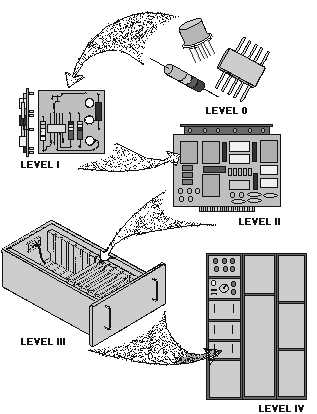1-34
account all environmental and electrical factors that may affect the system. This includes temperature,
humidity, vibration, and electrical interference. The design factor that has the greatest impact on you, as
the technician, is the MAINTAINABILITY of the system. The designer must take into account how well
you will be able to locate problems, identify the faulty components, and make the necessary repairs. If a
system cannot be maintained easily, then it is not an efficient system. PACKAGING, the method of
enclosing and mounting components, is of primary importance in system maintainability.
Levels of Packaging
For the benefit of the technician, system packaging is usually broken down to five levels (0 to IV).
These levels are shown in figure 1-36.
Figure 1-36.—Packaging levels.
LEVEL 0.—Level 0 packaging identifies nonrepairable parts, such as integrated circuits, transistors,
resistors, and so forth. This is the lowest level at which you can perform maintenance. You are limited to
simply replacing the faulty element or part. Depending on the type of part, repair might be as simple as
plugging in a new relay. If the faulty part is an IC, special training and equipment will be required to
accomplish the repair. This will be discussed in topic 2.
LEVEL I.—This level is normally associated with small modules or submodules that are attached to
circuit cards or mother boards. The analog-to-digital (A/D) converter module is a device that converts a
signal that is a function of a continuous variable (like a sine wave) into a representative number sequence
in digital form. The A/D converter in figure 1-37 is a typical Level I component. At this level of



